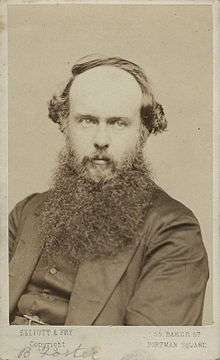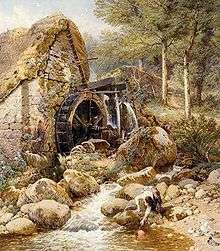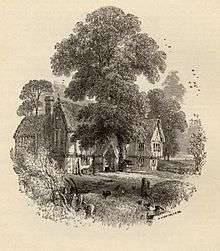Myles Birket Foster


Myles Birket Foster (4 February 1825 – 27 March 1899) was a popular English illustrator, watercolour artist and engraver in the Victorian period. His name is also to be found as Myles Birkett Foster.
Life and work
Foster was born in North Shields, England of a primarily Quaker family, but his family moved south to London in 1830, where his father founded M. B. Foster & sons — a successful beer-bottling company.[1] He was schooled at Hitchin, Hertfordshire[2] and on leaving initially went into his father's business. However, noticing his talent for art, his father secured an apprenticeship with the notable wood engraver, Ebenezer Landells,[2] where he worked on illustrations for Punch magazine and the Illustrated London News.

On leaving Landells' employ, he continued to produce work for the Illustrated London News and the Illustrated London Almanack. He also found work as a book illustrator and, during the 1850s, trained himself to paint in watercolours. His illustrations of Longfellow’s Evangeline and books of poetry by other contemporaries were a great success,[2] and he quickly became a successful artist in watercolours. Birket Foster became an Associate of the "Old" Watercolour Society (Later the Royal Watercolour Society) in 1860[3] and exhibited some 400 of his paintings at the Royal Academy over more than 2 decades.
Birket Foster travelled widely, painting the countryside around Scotland, the Rhine Valley, the Swiss lakes and in Italy, especially Venice. In 1863 he moved to Witley, near Godalming in Surrey where he had a house ("The Hill") built. Being friendly with Edward Burne-Jones and William Morris, he had the house decorated and furnished in contemporary style, with tiles and paintings by Burne-Jones and Morris' firm, Morris and Company. The same year he published a volume of "English Landscapes," with text by Tom Taylor.[4]
Although he had painted great numbers of landscape scenes from Scotland to the Mediterranean, it was after moving to Witley that Birket Foster produced the works for which he is best known—a sentimentalised view of the contemporary English countryside, particularly in the west Surrey area. Although criticised for their idealised view of rural life, they were recognised for their detail and execution. Birket Foster's work (along with that of other artists) was used by Cadburys, the chocolate manufacturer, on the cover of their chocolate boxes from the 1860s onwards.[5]
He became ill in 1893 and moved to Weybridge. He continued painting, but died on 27 March 1899. His obituary in The Times referred to him as "certainly the most popular water-colour artist of our time".[6] He is buried at All Saints' Church in Witley. When his father, Myles Birket Foster died, the artist son's obituary was published.
His son, Myles Birket Foster (1851–1922), was an organist who composed cantatas for children's voices and wrote a History of the Philharmonic Society, 1913.
References
- ↑ Records of M.B. Foster and Sons Ltd (The National Archive, UK)
- 1 2 3 The Times Wednesday 29 March 1899
- ↑ victorianweb.org
- ↑ The Times, 29 March 1899
- ↑ Cloke, Marsden & Mooney. Handbook of rural studies (Sage Pubs. Ltd., 2006), p141.
- ↑ 'Death of Mr. Birket Foster', The Times, 29 March 1899, p. 11.
Bibliography
- Illustrated by Foster
- Foster, Myles Birket. Beauties of English Landscape (Routledge, Warne & Routledge, 1862).
- Gillies, Mary. The Carewes: A Tale of the Civil Wars (W. Kent & Co, 1861).
- Taylor, Tom. Birket Foster's pictures of English landscape (George Routledge & sons, 1874).
- Wordsworth, William. The Deserted Cottage (George Routlege & Co., 1859).
- Wordsworth, William. Poetical Works (G. Routledge, 1858).
- About Foster
- Cundall, Herbert Minton. Birket Foster, R. W. S (A & C Black, 1906); with colour plates.
- Cundall, Herbert Minton. Birket Foster, sixteen examples in colour of the artist's work (A. & C. Black, 1910).
- Lewis, Frank. Birket Foster (Leigh on Sea: Lewis, 1973).
- Reynolds, Jan. Myles Birket Foster (London: Batsford, 1984).
External links
| Wikimedia Commons has media related to Myles Birket Foster. |
| Wikisource has the text of the 1911 Encyclopædia Britannica article Foster, Myles Birket. |
- M B Foster online (ArtCyclopedia)
- M B Foster biography and works (The Border Collie Museum)
- M B Foster biography ("Exploring Surrey's Past")
- Biography (Victorian Art in Britain)
- Paintings by Miles Birket Foster (Art Renewal Center Museum)
- An old English mill (1881 etching)
- Works by Birket Foster at Project Gutenberg
- Works by or about Myles Birket Foster at Internet Archive